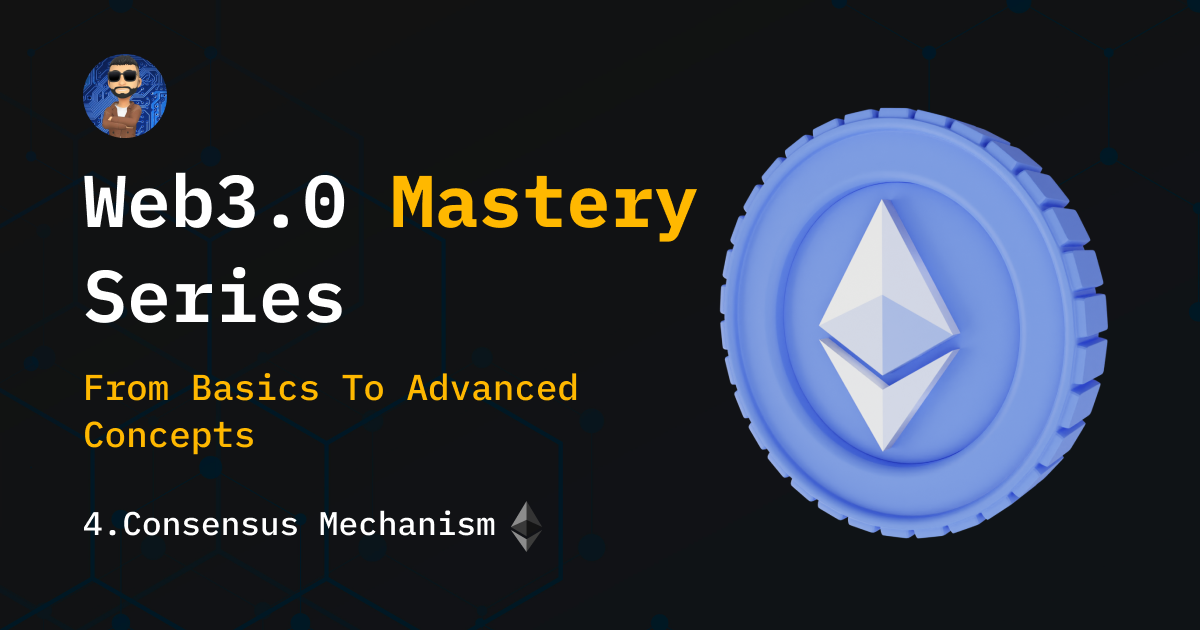Consensus Mechanism in Ethereum
 Prathamesh Patil
Prathamesh Patil
Consensus mechanism is the process through which participants in a decentralized network come to an agreement on the state of the network. In the context of blockchain technology, consensus is achieved by a network of nodes, each of which maintains a copy of the blockchain and works together to validate transactions and update the ledger.
In Ethereum, the consensus mechanism has evolved over time, and the current consensus mechanism is different from the one used in the early days of the network. Here is a brief overview of the consensus mechanisms used in Ethereum before and now:
Proof Of Work (PoW)
Proof of Work (PoW) is a consensus mechanism used in blockchain technology to validate transactions and maintain the integrity of the blockchain network. The PoW algorithm requires participants, also called nodes or miners, to solve complex mathematical puzzles in order to validate new blocks of transactions and add them to the blockchain.
In a PoW system, a node that wants to add a block to the blockchain must first compete with other nodes to solve a difficult mathematical problem. The problem is designed to be difficult to solve, but easy to verify once a solution has been found. The first node to solve the problem and find a solution broadcasts its solution to the network, and the other nodes verify the solution. If the solution is correct, the node that solved the problem is rewarded with newly minted cryptocurrency or transaction fees, and the validated block is added to the blockchain.
The PoW algorithm is energy-intensive because nodes need to use significant computational resources to solve the mathematical puzzles. As more nodes join the network and compete to solve the puzzles, the difficulty of the problems increases, requiring even more computational power. This has led to concerns about the environmental impact of PoW-based blockchain networks.
Despite its energy consumption, PoW is widely used in many popular blockchain networks, including Bitcoin and Ethereum. The security and reliability of the PoW consensus mechanism make it an attractive option for maintaining the integrity of blockchain networks. However, as concerns about the environmental impact of PoW continue to grow, many blockchain networks are exploring alternative consensus mechanisms, such as Proof of Stake (PoS), which requires less energy consumption.
Terms in PoW
Block: A group of transactions that are added to the blockchain network as a single unit.
Hash: Each block in the blockchain contains a unique code called a "hash," which is a digital fingerprint of the data within the block. This hash is used to link the block to the previous block in the chain, creating a continuous and unbroken chain of blocks. Once a block has been added to the blockchain, it cannot be altered or deleted, providing a high level of security and immutability.
Hash Rate: The total amount of computational power used by all miners on the network to solve mathematical problems.
Difficulty: A measure of how difficult it is to solve the mathematical problems required to create a new block in the blockchain network.
Target: A value that the solution to the mathematical problem must be lower than in order to be accepted as valid by the network.
Nonce: A random value that miners add to the block's header as part of the hashing process.
Block Reward: The amount of cryptocurrency or transaction fees that a miner receives for successfully creating a new block in the blockchain.
Block Production: In a PoW system, miners compete to create a new block of transactions and add it to the blockchain. To do this, miners must solve a mathematical puzzle that is designed to be difficult to solve but easy to verify. The first miner to solve the puzzle and create a new block is rewarded with newly minted cryptocurrency or transaction fees.
Network Security: PoW provides network security by making it very difficult and expensive for a malicious actor to change the contents of the blockchain. In order to change the contents of the blockchain, an attacker would need to have control of more than 50% of the network's computing power. This is called a "51% attack" and is extremely difficult and expensive to carry out in a PoW system.
Difficulty Adjustment: The difficulty of the mathematical problems that miners must solve is adjusted regularly in a PoW system to maintain a consistent block time. As more miners join the network and compete to solve the puzzles, the difficulty increases to ensure that blocks are not produced too quickly.
51% Attack: An attack on the blockchain network that involves a single entity or group of entities controlling more than 50% of the network's computational power, allowing them to manipulate the contents of the blockchain.
Energy Consumption: The amount of energy consumed by miners to solve the mathematical problems required to create a new block in the blockchain network.
Proof of Stake (PoW)
Proof of Stake (PoS) is the consensus mechanism that Ethereum is currently in the process of transitioning to. In the Ethereum PoS algorithm, nodes that hold a certain amount of ether (ETH) are chosen to validate new transactions and add them to the blockchain.
In the Ethereum PoS system, nodes are called validators instead of miners. Validators are chosen to create new blocks based on the amount of ether they have "staked" or locked up as collateral. The more ether a validator stakes, the higher the chance they have of being selected to validate transactions and earn rewards.
In Ethereum's PoS algorithm, validators are chosen based on a combination of factors, including the amount of ether they have staked, the length of time they have been staking, and their history of honest behavior on the network. Validators are incentivized to act in the best interest of the network by earning rewards for their validation work and losing some or all of their staked ether if they act maliciously or incorrectly.
One of the main benefits of the Ethereum PoS algorithm is that it is significantly more energy-efficient than the PoW algorithm. Validators do not need to use specialized mining hardware and consume vast amounts of electricity to solve complex mathematical problems. Instead, they simply need to hold a certain amount of ether and run software that allows them to participate in the validation process.
The transition to Ethereum's PoS algorithm is being rolled out in phases, with the first phase (called the Beacon Chain) launched in December 2020. The full transition to PoS is expected to be completed in 2022, with the launch of the Ethereum 2.0 network.
Terms in PoS
Validator: A node that is responsible for validating transactions and adding new blocks to the blockchain network in a PoS system.
Stake: The amount of cryptocurrency held by a validator that is used to participate in the consensus process and validate transactions.
Block Production: In a PoS system, validators take turns producing new blocks and adding them to the blockchain based on their stake and other factors.
Network Security: PoS provides network security by requiring validators to have a significant stake in the network. Validators with a larger stake have a greater incentive to act honestly and maintain the integrity of the network.
Slashing: A penalty that is imposed on validators who behave dishonestly or attempt to manipulate the network. Slashing can result in the loss of a portion of the validator's stake.
Finality: The state in which a block has been added to the blockchain and cannot be reversed or changed.
Epoch: A fixed period of time during which validators take turns producing new blocks and validating transactions.
Casper: A specific PoS protocol that is being developed for the Ethereum blockchain.
Overall, PoS is a newer consensus mechanism than PoW and is designed to address some of the energy consumption and scalability issues associated with PoW. In a PoS system, validators are incentivized to behave honestly and maintain the integrity of the network, with penalties imposed on those who act maliciously or attempt to manipulate the system. PoS is used in several blockchain networks, including Ethereum, Cardano, and Tezos.
Pros and Cons Of PoW
Pros:
Security: PoW has proven to be a secure consensus mechanism, as it is difficult and resource-intensive to manipulate the blockchain network by controlling the majority of the computational power.
Decentralization: PoW encourages decentralization, as anyone with sufficient computational power can participate in the mining process and help secure the network.
Established: PoW is an established and well-tested consensus mechanism that has been used in several blockchain networks, including Bitcoin and Ethereum.
Cons:
Energy Consumption: PoW requires a significant amount of computational power, which results in high energy consumption and carbon emissions, making it an environmentally unfriendly consensus mechanism.
Centralization: PoW can lead to centralization, as larger mining pools can dominate the network, resulting in a concentration of power and control.
Scalability: PoW can become slow and inefficient as the number of transactions increases, making it difficult to scale the network.
Pros and Cons Of PoS
Pros:
Energy Efficiency: PoS is more energy-efficient than PoW, as it does not require the same level of computational power, making it a more environmentally friendly consensus mechanism.
Decentralization: PoS encourages decentralization, as anyone with a sufficient stake can participate in the validation process and help secure the network.
Scalability: PoS is designed to be more scalable than PoW, as it does not require as much computational power to validate transactions, making it easier to scale the network.
Cons:
Security: PoS is still a relatively new and untested consensus mechanism, and there are concerns that it may be more vulnerable to attacks than PoW.
Centralization: PoS may also lead to centralization, as those with larger stakes have more influence and control over the network.
Fairness: There are concerns that PoS may not be as fair as PoW, as those with larger stakes have a greater advantage and can potentially accumulate even more wealth and power through the validation process.
Overall, both PoW and PoS have their own advantages and disadvantages, and the choice of consensus mechanism depends on the specific needs and goals of the blockchain network. While PoW has proven to be a secure and established consensus mechanism, it has also been criticized for its high energy consumption and scalability issues. PoS offers a more energy-efficient and scalable alternative, but it is still a relatively new and untested consensus mechanism.
Conclusion
Based on our discussion about Proof of Work (PoW) and Proof of Stake (PoS), it is clear that there are advantages and disadvantages to both consensus mechanisms. The choice of consensus mechanism depends on the specific needs and goals of the blockchain network.
In the next article, we will dive into the Ethereum Virtual Machine (EVM), which is a key component of the Ethereum blockchain. The EVM is a virtual machine that runs smart contracts written in programming languages such as Solidity, allowing developers to create decentralized applications (dapps) on the Ethereum network.
I hope the information provided was helpful and informative. If you have any further questions or need clarification, feel free to leave a comment or reach out to me through Twitter or LinkedIn. It would be great to connect and continue the conversation.
👋Thank you for taking the time to read this article. Until next time!
Subscribe to my newsletter
Read articles from Prathamesh Patil directly inside your inbox. Subscribe to the newsletter, and don't miss out.
Written by
